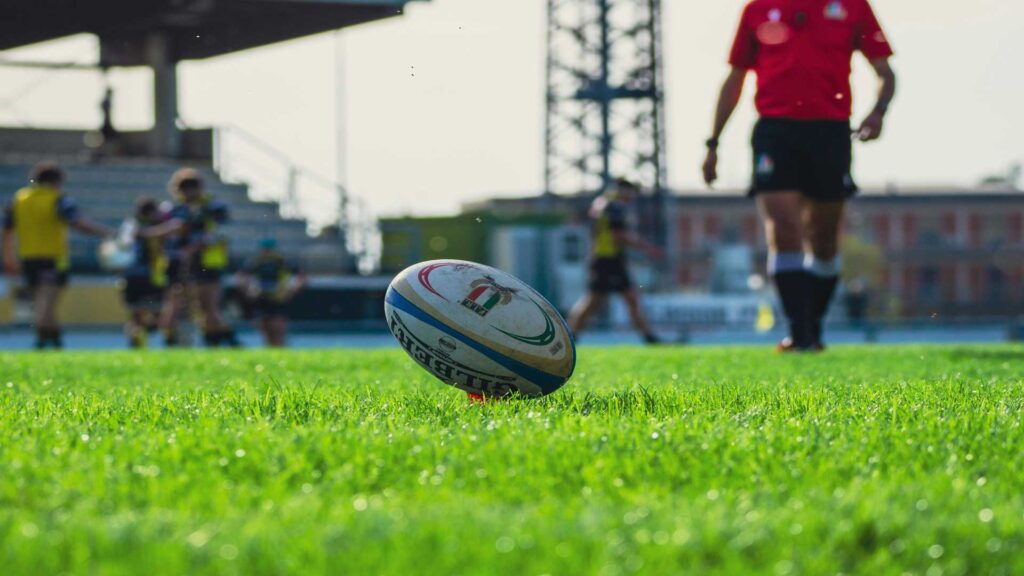Whether you’re a beginner trying to wrap your head around rugby or someone just curious about the sport, understanding the field’s dimensions and the equipment used can help make the game less of a mystery. Rugby is played on a rectangular field, but there’s more to it than that. There are specific measurements, goalposts, and lines that shape the game, and let’s not forget the gear that players wear to survive the brutal tackles. Here’s a rundown of everything you need to know about the field and the kit that makes the game possible.
Rugby Field Dimensions: A Brief Overview
First off, let’s talk about the size of the field. A rugby field, also known as a pitch, is huge. It’s bigger than a soccer field and definitely larger than what you see in American football. The standard size of a rugby field is 100 meters long and 70 meters wide. That’s a lot of space to cover, especially when you’re running after a ball that rarely stays in a straight line!
The field is divided into halves, with a halfway line smack in the middle. The try lines—similar to end zones in American football—are at each end of the field, running parallel to the halfway line. Beyond the try lines are the in-goal areas, which extend an additional 10 to 22 meters past the try lines. These in-goal areas are where the magic happens; it’s where players score tries by grounding the ball. But don’t just take my word for it—when you’re on the field, that distance feels a whole lot longer, especially with defenders breathing down your neck.
Key Lines and Markings
If you’re standing on a rugby field for the first time, all the lines can seem a bit overwhelming. But each line has a specific purpose, and once you know what they are, the field starts making a lot more sense.
- Halfway Line: This one’s easy—it’s the line that divides the field into two equal halves.
- 22-Meter Lines: These are 22 meters from each try line and serve as defensive boundaries for teams. They are significant for kick-offs and when teams need to clear the ball from their own end.
- 10-Meter Line: This line is 10 meters from the halfway line on both sides. During a kickoff, the ball must travel past this line for play to continue.
- 5-Meter Line: You’ll find these near the try lines and sidelines, used primarily during scrums and lineouts to make sure play is fair and safe.
While these lines might seem like mere markers, they play a crucial role in shaping the game. For instance, if you’re inside your own 22-meter line, kicking the ball out of bounds without it bouncing first is legal and a common way to relieve pressure.
The Rugby Goalposts: Tall and Narrow
Rugby goalposts look somewhat like oversized tuning forks, standing tall at each end of the field. The posts are spaced 5.6 meters apart, with the crossbar set at a height of 3 meters from the ground. And believe me, trying to kick the ball between those uprights under pressure isn’t as easy as it looks.
These goalposts are used for scoring goals through kicks, whether after a try, during a penalty kick, or with a drop goal. Kicking requires pinpoint accuracy, especially since the posts are much narrower than what you see in other sports.
Understanding the Rugby Ball
Next up, we’ve got the rugby ball. It’s not quite round, and it’s not entirely oval either. It’s more of an ellipsoid shape, which can make its movement pretty unpredictable. The standard rugby ball is about 28 to 30 centimeters long and weighs roughly 400 to 460 grams. It’s designed for both handling and kicking, and its shape is specifically meant to accommodate the passing style unique to rugby.
Fun fact: The first rugby balls were made from pigs’ bladders wrapped in leather. Fortunately, technology has moved on, and now they’re made of synthetic materials that are more durable and much less, let’s say, “organic.”
Rugby Boots: Not Your Average Shoes
Like any sport, rugby has specific footwear that players rely on. Rugby boots resemble soccer cleats, but they tend to be a bit sturdier. Why? Because in rugby, you’re not just running and kicking—you’re also pushing, tackling, and scrummaging. You need boots that can handle the pressure.
The soles of rugby boots are fitted with studs, which are essential for gripping the turf, especially when conditions are wet and muddy. These studs are generally longer than those used in soccer boots, offering more traction and stability. The type of studs you use can depend on your position—backs might opt for lighter boots with shorter studs, while forwards may need something with a bit more grip for scrums and tackles.
Protective Gear: Not as Much as You Think
Rugby might look like a sport where players are decked out in armor, but you’d be surprised at how little protection they actually wear. That’s right—rugby players are tough, but they’re not invincible.
- Mouthguards: The one piece of mandatory equipment is the mouthguard. Given the physical nature of the sport, protecting your teeth is essential. No one wants to leave the field with fewer teeth than they started with.
- Headgear: Some players wear soft headgear, often called scrum caps, to protect their ears during scrums and reduce the risk of head injuries. However, these caps offer limited protection compared to helmets in other sports.
- Shoulder Pads: A small number of players wear light shoulder padding, but these pads are nothing like the bulkier ones used in American football. They’re designed to offer just a bit of cushion without restricting movement.
Despite the minimal protective gear, rugby remains a physically demanding and contact-heavy sport. Injuries do happen, but the culture of rugby emphasizes proper tackling techniques and respect for fellow players to minimize unnecessary risks.
For those interested in learning more about rugby-related injuries and the protective gear players use, check out this study.
The Role of the Referee
Rugby matches rely heavily on the referee, whose job it is to enforce the rules and maintain order. Unlike some sports where refs may be overlooked, rugby referees play a central role in the game. They communicate constantly with players, often explaining decisions on the fly. Respect for the referee is also a deeply ingrained part of rugby culture, making for a generally more disciplined and respectful atmosphere than in some other sports.
If you’re interested in how the referee interacts with the game and enforces the rules, this article provides some fascinating insights.
Getting to Know the Pitch
The rugby pitch may seem like just a giant field, but once you break down the dimensions and equipment, it’s clear that every part of it plays a role in how the game unfolds. From the massive in-goal areas to the strategic importance of the 22-meter line, the layout of the field is as much a part of the game as the players themselves.
In rugby, you don’t just play the opposition—you play the field too. Its size, shape, and conditions can change how teams approach the game. Wet and muddy fields might turn the game into a slugfest, while dry, firm ground allows for more expansive, running rugby. Understanding the field is just as crucial as understanding the rules.
Wrapping It Up
Whether you’re just getting into rugby or looking to deepen your understanding, knowing the dimensions of the field and the equipment used is a great place to start. From the length and width of the pitch to the gear players rely on, each element contributes to the sport’s unique character. And next time you’re watching a game, you’ll know exactly why players kick for touch, why those try lines are so far apart, and why even the smallest piece of equipment can make a huge difference in how the game plays out.
Frequently Asked Questions
What are the standard dimensions of a rugby field?
The standard dimensions of a rugby field are 100 meters (328 feet) in length and 70 meters (230 feet) in width, excluding the in-goal areas.
How long is a rugby field, including the in-goal areas?
Including the in-goal areas, a rugby field is up to 144 meters (472 feet) long. Each in-goal area can be up to 22 meters (72 feet) deep.
What is the width of a rugby field?
A rugby field is 70 meters (230 feet) wide, which is consistent across most levels of play.
How large are the in-goal areas in rugby?
The in-goal areas extend up to 22 meters (72 feet) beyond the goal line on each end of the field, making them some of the largest in any sport.
How tall are the rugby goalposts?
Rugby goalposts stand at least 3.4 meters (11.2 feet) high, with a crossbar 3 meters (9.8 feet) above the ground.
What materials are rugby goalposts made from?
Rugby goalposts are typically made from steel or aluminum for strength and durability, with padding around the base for player safety.
What type of grass is used on rugby fields?
Most professional rugby fields use natural grass, though hybrid grass (a blend of natural and synthetic) is becoming more common. Some fields also use fully synthetic turf for all-weather play.
What are the markings on a rugby field?
Rugby fields have several key markings: the halfway line, 22-meter lines, 10-meter lines, 5-meter lines, and touchlines, as well as the goal lines and dead-ball lines. These help regulate the game’s flow and position.
What equipment is required to play rugby?
Basic rugby equipment includes the rugby ball, goalposts, a mouthguard, boots with studs or cleats, and, in some cases, scrum caps for head protection.
How does the rugby ball differ from other sports balls?
A rugby ball is oval-shaped and larger than an American football, measuring approximately 27 cm (10.6 inches) in length and 60 cm (24 inches) in circumference at its widest point.
What protective gear is allowed in rugby?
The most common protective gear in rugby is a mouthguard and optional headgear (scrum cap). Players may also wear padded shirts or vests, but padding must be lightweight and approved by World Rugby.
Are there any specific shoes or cleats for rugby?
Yes, rugby boots or cleats are designed for grip and support on grass. The studs on rugby boots are often longer than those for other sports, giving extra traction during scrums and rucks.
What is the significance of the halfway line in rugby?
The halfway line marks the center of the field, where the match starts and restarts after a try or goal. It also plays a role in determining where kickoffs occur.
How are rugby fields maintained for professional matches?
Professional rugby fields are regularly mowed, watered, and treated to ensure optimal playing conditions. Ground staff also manage drainage systems to prevent waterlogging and use linesmen to repaint field markings as needed.
How do rugby field dimensions differ between leagues or countries?
The field dimensions generally remain the same across countries and leagues as World Rugby sets the standard dimensions. However, in some amateur and youth leagues, field size may vary slightly depending on available space.
Are rugby fields the same size for all levels of play?
For adult professional and amateur matches, the field dimensions remain the same. However, for youth rugby, fields are often scaled down to suit the age and skill level of the players.
What safety measures are taken regarding rugby field equipment?
Safety measures include padding around the goalposts and ensuring that the field surface is even and free of hazards like rocks or divots. Referees inspect the field before games to ensure safety standards are met.
How far apart are the goalposts in rugby?
The goalposts are 5.6 meters (18.4 feet) apart, which is the same across all levels of play.
What are the dimensions of the touchlines and dead-ball lines?
The touchlines (sidelines) run the length of the field, while the dead-ball lines mark the end of the in-goal areas. Both are positioned to create boundaries beyond which play is stopped.
How does weather affect rugby field conditions and equipment choices?
Wet or muddy conditions can affect the grip and movement of players, so they often switch to longer studs for better traction. Games in rainy or windy conditions may also require special handling of the ball to avoid slipping.




Pingback: Understanding Rugby Rules, Scoring, and Gameplay Explained